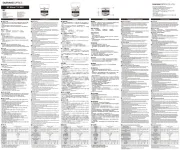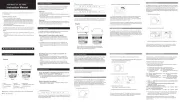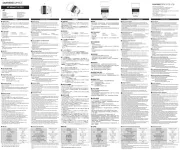
Canon / Canon M /Fujifilm X / Sony α / Sony E / FT / MFT / NX Mount
1) Record a video in mode.
2) Please note that while recording a video the shutter speed is limited to a minimum
(The procedures above are for the K-30. The settings for the camera or the menu may varybased on
the camera model or due to a functional upgrade. Refer to the camera manual or contactthe camera
manufacturer for detailed information.)
Please read this instruction manual prior to use.
Thank you for purchasing the 10mm T3.1 ED AS NCS CS
We believe that you will have a special photographic experience with the 10mm T3.1
The 10mm T3.1 ED AS NCS CS lens forms an optical system based on superior
optical technologies, and maintains excellent resolution both at the center and around
the periphery of the lens by incorporating a high performance Glass Molding ASP lens
and UMC (Ultra Multi Coating).
Please read this instruction manual carefully and use it accordingly.
※ Please read the Safety Precautions at the back of this instruction manual prior to use.
Some cameras require special settings when using this lens.
1) Record a video in Av, Tv, P, CA,
2) Please note that while recording a video the shutter speed is limited to a minimum
(The procedures above are for the 5D MARKII. The settings for the camera or the menu may vary
based on the camera model or due to a functional upgrade. Refer to the camera manual or contact
the camera manufacturer for detailed information.)
Please refer to the following and set the camera when necessary.
1) Record a video in M or A mode.
2) Adjust the exposure using the dial steps +5 to -5.
(The procedures above are for the D7000. The settings for the camera or the menu may vary based
on the camera model or due to a functional upgrade. Refer to the camera manual or contact the
camera manufacturer for detailed information.)
Advantages of the 10mm T3.1 ED AS NCS CS lens
The 10mm T3.1 ED AS NCS CS lens for video recording is designed with its own
mount. You can mount the lens directly onto the camera without using an additional
1. Component Names 2. Attaching and Detaching
① ④ ⑦ Mount Hood Aperture adjustment gear
② ⑤ Reference line Distance scale
③ ⑥ Focusing gear Red ring
10mm T3.1 ED AS NCS CS lens mount is uniquely designed for Canon, Nikon
(Fujifilm) F, Pentax (Samsung GX) K, Sony (Minolta) α, Canon M, Sony E, Fujifilm X,
Samsung NX, Four Thirds, and Micro Four Thirds cameras.
Gently hold the lens and align the camera mount attachment point with the
attachment reference point or line on the lens. Push the lens into the camera and
gently rotate the lens in the attachment direction until it makes a clicking sound.
Gently hold the lens, press the lens release button on the camera, and turn the lens
in the opposite direction of the attaching direction to detach the lens.
When using the 10mm T3.1 ED AS NCS CS lens, you can set the focus of a subject
by turning the focusing ring, since it is an MF (Manual Focus) adjustment lens.
You can set the desired brightness by turning the aperture adjustment gear when
using the 10mm T3.1 ED AS NCS CS lens.
You can set the T stop from T3.1 to 22.
(The aperture is not positioned at any exact point, since it is adjustable continuously.)
① To change the focus from a subject that is far away to a subject that is close,
turn the focusing gear to the left (from ∞ to 0.24 m) and focus on the clearest
subject by using the indication signal on the camera or by checking visually.
② To change the focus from a subject that is close to a subject that is far away,
turn the focusing gear to the right (from 0.24 m to ∞) and focus on the clearest
subject by using the indication signal on the camera or by checking visually.
① To change the focus from a subject that is far away to a subject that is close,
turn the focusing gear to the right (from ∞ to 0.24 m) and focus on the clearest
subject by using the indication signal on the camera or by checking visually.
② To change the focus from a subject that is close to a subject that is far away,
turn the focusing gear to the left (from 0.24 m to ∞) and focus on the clearest
subject by using the indication signal on the camera or by checking visually.
1) Record a video in A, S, P or M mode.
(The procedures above are for the A580. The settings for the camera or the menu may vary based
on the camera model or due to a functional upgrade. Refer to the camera manual or contact the
camera manufacturer for detailed information.)
1) Record a video in Av, Tv, P, CA or M mode.
2) Please note that while recording a video the shutter speed is limited to a minimum
(The procedures above are for the Canon M. The settings for the camera or the menu may vary
based on the camera model or due to a functional upgrade. Refer to the camera manual or contact
the camera manufacturer for detailed information.)
1) Record a video in A, S, P or M mode.
2) Adjust the exposure by rotating the dial at the back of the camera.
(The procedures above are for the NEX-5. The settings for the camera or the menu may vary based
on the camera model or due to a functional upgrade. Refer to the camera manual or contact the
camera manufacturer for detailed information.)
1) Record a video in mode.
(The procedures above are for the X-Pro1. The settings for the camera or the menu may vary based
on the camera model or due to a functional upgrade. Refer to the camera manual or contact the
camera manufacturer for detailed information.)
1) Record a video in A, M or mode.
2) Please note that while recording a video the shutter speed is limited to a minimum
(The procedures above are for the NX-200. The settings for the camera or the menu may vary
based on the camera model or due to a functional upgrade. Refer to the camera manual or contact
the camera manufacturer for detailed information.)
1) Record a video in , P, A or M.
2) Please note that while recording a video the shutter speed is limited to a minimum
(The procedures above are for the E-5. The settings for the camera or the menu may vary based on
the camera model or due to a functional upgrade. Refer to the camera manual or contact the
camera manufacturer for detailed information.)
1) Record a video in , P, A or M.
2) Please note that while recording a video the shutter speed is limited to a minimum
(The procedures above are for the E-5. The settings for the camera or the menu may vary based on
the camera model or due to a functional upgrade. Refer to the camera manual or contact the
camera manufacturer for detailed information.)
8.0 10.5 9.0 10.0 36.8 29.0 36.5 15.8 35.536.4
Issue Causes Corrective Action
A lens cannot be attached to
The attachment reference point
on the lens is not aligned with
the lens attachment reference
Align the attachment reference point
on the lens with the lens attachment
reference point on the camera.
A lens cannot be detached
Incorrect rotation direction for
If you turn the lens while holding
Press the lens release button on the
camera, and gently turn the lens to the
lens attaching/detaching reference
points, in the direction as marked on the
camera, and then pull the lens forward.
Insufficient shutter speed or
Turn the focusing gear while checking
the indication or checking an object
visually, set the focus until it becomes
clear, and then press the shutter.
Steady the camera and take a
photograph at a shutter speed of
Automatic focusing does not
A manual focusing lens has
trouble with automatic focusing.
Use the focusing gear to adjust the
Dark or too bright pictures
Adjust the aperture adjustment gear
The manual control lens may
not be compatible, depending
The camera finder indication
This lens does not have an
electric contact signal, so there
is no communication with the
camera through electric signals.
This lens is a single lens.
This lens cannot be mounted
This lens is designed for its own
Purchase the designated lens mount.
You want to attach our 2X or
Our converter is designed for
the T (M42 screw) mount only.
Therefore it cannot be used with
Use each company's own mount
converter. However, be aware that
auto focusing is unavailable.
Do not wet this product or expose it to a moist environment. It may cause a
Do not use this product or store it close to devices that generate heat i.e.,
heaters, thermal regulators, stoves or stereo amplifiers.
Do not leave the lens in conditions where drastic temperature changes can
Do not touch the surface of the lens by hand, and avoid making contact with
Do not soak the lens in water, and avoid water splashing onto the lens.
If there are foreign bodies on the lens, use a lens cleaning kit only.
If the lens hood is cut by the user, it may cause damage to the surface of the
lens, as the surface of the lens may make contact with the floor.
ensure the lens is held in place
properly; otherwise the lens may
become loose and cause an
Don't put excessive pressure
on the lens attached to the
cause damage to the lens or
to the camera mount. Be sure to
hold the lens when operating or
checking the lens beforehand or by
test shooting for important events
Don't leave the lens within
reach of babies, as it may
cause injury to the baby if the
lens falls or is dropped.
Don't attempt to modify or
alter the lens. It may lead
to failure of the camera. Modified
or altered lenses may not be
cause a fire, depending on
directly through a camera
with a lens attached. It may
Tick
If this instruction is not
followed, it may cause death
or severe injury to the user.
If this instruction is not
followed, it may cause death
or severe injury to the user.
The following precautions are divided into two types
according to the level of danger.
The following pictograms are used in the below precautions:
Requires caution. Inside the pictogram it shows contents of precautions.
(It shows outbreak of fire in the pictogram on the left.)
Shows prohibition. Inside the pictogram it shows contents of prohibition.
(It shows prohibition of dismantling in the pictogram on the left.)
Shows instruction. Inside the pictogram it shows contents of instructions.
(It shows instruction of precaution in the pictogram on the left.)
NCS (Nano Coating System)
132.4 111.4 1301 124.6 32.1 .9
59 60 90 595 35 30 6200 0 5 6 630 625 6 630




















